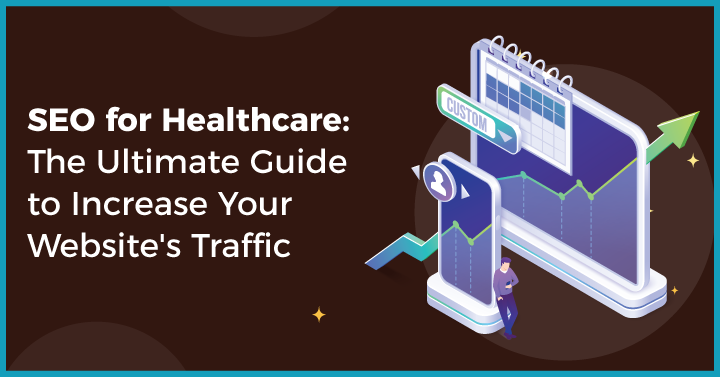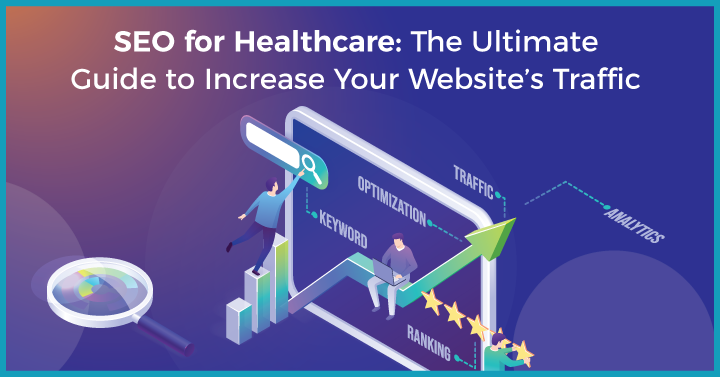Did you know – 66% of internet users look online for information about a specific medical problem or health condition? With a 15% close rate of organic search, you must ensure you remain competitive in reaching new patients and growing your business. Search engines are significant in distributing health-related information to millions of people. As a result, many healthcare organisations are investing in SEO to improve their online visibility and acquire more patients. In this post, we have compiled the best SEO practices for healthcare to increase reach and drive potential traffic to your medical website.
You can also explore some of our best articles on SEO –
- 8 Best Practices To Improve SEO For Nonprofits And Charities
- A Step-By-Step Guide In SEO For B2B SaaS Businesses
- 10 Practical Tips To Boost SEO For SaaS And Generate Leads
- Ultimate Guide To SEO For EdTech: Boost Your Online Presence
1. What Is Healthcare SEO?
Healthcare SEO is the practice of optimising a healthcare website for search engines to drive organic traffic. SEO for healthcare enables your business to rank on the first page of SERPs for relevant keywords and get the prospective audience’s attention. For instance, if you are a cardiac surgeon, you may want someone to type “coronary angiogram test near me” in the Google search bar and find your practice. With a solid SEO strategy for healthcare, you will reach people based on the keywords or phrases they use.
2. Benefits of SEO in Healthcare

- Increase website traffic
SEO for healthcare helps improve website traffic, as Google drives 51% of organic traffic. By using relevant keywords people are searching for, you can attract potential customers to your website. Reputed search engines like Google, Bing, and Yahoo rank your website based on the keywords, which help you drive relevant traffic to your website.
- Builds credibility
When people read informative and valuable content on your healthcare website or blog, they will consider you as an expert in the field. Credibility helps you increase organic traffic, as you will appear on top of search results. The rank of your website depends on the type of content you post on your website. It helps your patients find the correct information, which builds trust in your practice
- High-quality leads
Healthcare SEO helps you generate high-quality leads by targeting a specific bracket of people interested in your healthcare services. Also, it enables you to grab the attention of local audiences searching for the best healthcare centres around them. For instance, if someone types “best cardiologist near me,” you will likely be shown on top of search results. By listing in local business directories, you can be shown up in local search results.
- Generate highest ROI
SEO for healthcare is a cost-effective way to build brand awareness and get more meaningful traffic. When people see you more often in search results, they visit you more often and continue their journey to becoming potential clients. Once you gain traction in SERPs, it becomes easier to rank for high-value keywords, which means more business and ROI. Although advertising also helps drive targeted traffic, it is more expensive than SEO in the long run. Since you are not paying for every click, it is still worth investing in SEO – if you consider the costs of updating your website or blogs.
3. 7 SEO for Healthcare Strategies to Drive Traffic

3.1 Keyword Research
Many people turn to Google or other search engines when it comes to health-related queries. If you want your website to be shown on the top of SERPs, it should have the right keywords in the right places.
Keyword research is determining which search phrases potential patients use to find conditions you address or treatments you provide. It is one of the essential elements of SEO that helps you understand the search intent of the patient and what they are looking for. You need to use the right tools to determine the right keywords. You can find the best keywords for SEO for healthcare by using Google Keyword Planner, Ahrefs, or SEMRush.
To get the most out of keyword research, you also need to know about different types of keywords and the right way to use them. Below are the types of keywords –
- Broad keywords – These are the general terms 1-2 words in length and are referred to as root terms, using which most patients start their search. Examples: cardiologist, chest pain, cardiac specialist, angiogram, etc.
- Long tail keywords – These are more specific search terms 3-5 words in length. They contain the broad keyword along with location or specialisation. Examples: best cardiologist in Sydney, top 10 cardiologists in Australia, best cardiology hospitals in Brisbane, etc.
- Brand keywords – These are the keywords people use when searching for you or your hospital. Examples: The Prince Chares Hospital, Pacific Cardiology, NSW Cardiology, etc.
3.2 Content Creation
Healthcare content plays a vital role in boosting SEO efforts. It is valuable to your audience and helps increase brand awareness, engagement, and conversion. Healthcare content creation involves understanding the on-page and off-page SEO aspects and producing quality content that fulfils the user intent. The most common types of healthcare content include – website content, landing pages, blogs, social media content, ebooks, online guides, press releases, case studies, and white papers.
Today, healthcare organisations offer virtual and digital experiences to create awareness of diseases, their symptoms, and treatment options. People are more likely to go for screenings, check-ups, and take preventive action by being aware of the disease and its symptoms. Whether a website or social media handles, there are ample opportunities to distribute your content and reach a wider audience. As a part of your healthcare SEO strategy, you should create content that helps you grow your brand.
You can distribute health-related content on multiple platforms, such as – Slack List, Product Hunt, HARO, Triberr, and Forbes BrandVoice.
3.3 On-Page SEO
On-page SEO is the technique of optimising the webpages to rank higher in SERPs for specific keywords. From the type of content you have on your website to mobile responsiveness & website loading speed – several factors impact the on-page SEO score of your website. Here are some considerations to improve the on-page SEO of your healthcare website –
- Title Tag – This is a backend part of your website that specifies the webpage’s title. Typically it is displayed on SERPs as a clickable link for a search result.
- Meta Description: It is shown beneath the title tag in SERPs that summarises the web page’s content.
- Mobile responsive – This is a vital part of SEO that lets your webpage fit into devices of different screen sizes without disrupting the quality.
- Keywords – The keywords are the phrases that determine what you want to be found for in SERPs
- Alt Tag – This appears on the images, which provides an alternative text to search engines to populate your webpage with relevant image tags
- H1 and H2 – Also known as header tags, these are used to communicate to search engines what your website is about
- Footer – the footer on your website helps easy navigation and identifies your site’s relevance on SERPs.
3.4 Off-Page SEO

Off-page SEO for healthcare refers to the actions taken outside your medical website to impact your ranking in SERPs. Google sees websites with hyperlinks (or backlinks) from high DA health-related websites as more important than websites without relevant links. As a part of your healthcare SEO strategy, you should get backlinks pointing back to your website from external sources. Besides, you also need to improve the internal links for better navigation. Here are the ways to get relevant and high-quality backlinks for your healthcare website –
- Online directories
Healthcare directories play a significant role in building high-quality backlinks. Online directories allow patients to find doctors based on their specialisation and location. Listing your organisation on some of the important directories seamlessly helps you reach a local audience. Some popular healthcare directories include – Google My Business, Yelp, Online Vitals, Healthgrades, Wellness, and more.
- Guest posting
Guest posting on healthcare websites is another way to get high-quality backlinks. There are plenty of paid and free sites that accept guest posts. You can collaborate with high DA sites to help you build your healthcare as a trusted authority. Some popular high-DA sites that accept guest posts on healthcare are – Breaking Muscle, Fitness Magazine, and Healthline Journal.
- Forum Posting
Forum posting is an integral part of SEO to build links to your website. With this off-page SEO tactic for healthcare, you can get real-time traffic to your website. Some popular forum submission sites for healthcare include – shapefit, Cough, healcity, healthinformaticsforum, and more – you can get high-quality backlinks for your site.
- Brand mentions
Brand mentions, also known as “implied link”, refers to the occasion when another company references your brand. It can be an article published on another website without a hyperlink to your website or blog. You can use tools like Awario, LocoBuzz, Mention, and SproutSocial to find out what others are talking about your brand on digital platforms.
- Influencer outreach
You can build healthcare backlinks and market to a new audience by reaching out to influencers in your niche and offering them a free product or commission in return for a backlink on their website. For instance, Kevin Pho, MD, is one of the prominent healthcare influencers. With 157k followers on Twitter, he is one of the popular influencers. You can partner with Dr Kevin to market your healthcare organisation.
3.5 Local SEO
Local healthcare SEO is a powerful strategy that helps medical practitioners gain substantial online visibility. In the basic sense, healthcare local SEO is all about increasing the visibility of your website for those searching for healthcare services in their area or vicinity. Optimising your site for local search results will help you –
- Bring your website to the top of local search results
- Improve your website’s user experience
- Make a positive first impression of a well-designed website
- Improves patient’s perception
To get started with healthcare local SEO, you need to include relevant keywords that help search engines to rank your website on local search results. Include location-based keywords in content, URLs, title tags, meta tags, and image file names.
Also, manage your local listings by providing everyone with accurate information about your practice. Make sure to keep – name, location, working hours, services and contact details consistent across local directories.
Ask for patient reviews, as more than 72% of patients trust online reviews to evaluate the credibility of medical practitioners. You can also be listed on popular healthcare review sites like – Doctor.com, Rate MDs, and WebMD
3.6 Technical SEO
Technical SEO for healthcare is a subset of on-page SEO that impacts your overall ranking and performance. A healthcare website with good medical SEO is easy for search engine robots to crawl, which means it is easy for patients to use. Below are some areas of a medical website that need to improve ranking on SERPs.
- Page Speed – The faster your medical website loads, the better the results. It should load quickly on any device – laptop, desktop, mobile or tablet. According to stats, more than 50% of website visitors leave or move to the following search results – if the speed is low. You can check the performance of your website on GTMetrix and PageSpeed Insights.
- Inactive links/pages – Your website should be free from redirects or no longer active pages. Broken links on the website are a sign of poor technical SEO, which hurts your score.
- Duplicate content – Duplicate healthcare content often confuses Google and forces it to choose which of the identical pages it should rank. You can eliminate it by writing a single version of the text for every website webpage.
- SSL – Google gives priority to a website that is secured. For this, your website should be encrypted with an SSL certificate. Choosing the right SSL certificate is the key consideration for a medical website.
- Schema Markup – Marketing up your content with structured content helps show the results in featured snippets. Schema.org is an initiative by Google, Bing, and Yahoo to give structure to your website.
- XML Sitemap – XML sitemap is a single page of your website that lists and categorises all the pages on your website.
3.7 Analytics & Reporting
Any SEO issue in healthcare marketing can negatively impact the overall performance if left unaddressed for a long time. Monitoring the results of your SEO efforts on Google Analytics is vital to maintain a successful strategy. There are several metrics to watch daily, weekly, and monthly to track the issues that hurt the performance of your website.
- Organic traffic – Any change in organic or referral traffic for a certain period should be monitored and rectified. Any dip in referral traffic is a sign of lost or dead backlinks.
- Sessions – Sessions can be defined as a group of actions of one user at a given time. It starts when the user enters the site and exits after a specific time. Evaluating the sessions will help you understand what is working and what’s not.
- Crawl errors – It is imperative to monitor the crawl report to understand the site’s health. Crawl errors make it harder for search engines to index your site, as a result of which the website traffic decreases.
- Branded keywords impressions – If you use branded keywords on your website, you need to measure the impressions using Google webmaster tools. Changes in impressions and clicks will help you understand the degrees of change in brand awareness.
- Keyword ranking – Remember that keyword trends change from time to time. Use google trends to understand the changing trends and optimise your content. Make adjustments to the keyword strategy if you lose rankings.
4. Case Study Examples of SEO for Healthcare

- WebMD
WebMD is the leading source of trustworthy health-related information and medical news. According to web.com traffic analytics report, the global rank of WebMD is 456, with 130 million visitors/month and 589 million backlinks. The website receives 66.57% of traffic from the United States alone and grabs the audience’s attention in the news & media publishing category. The top traffic source of webmd.com is search traffic, which is nearly 84.37%.
- Healthline
Healthline is another leading source that provides expert health guidance on various topics, including – nutrition, mental health, migraine, cancer, and other chronic diseases. According to Healthline traffic analytics report on Simlarweb, the global rank is 126, with 254.1 million visitors/month and 49.1 million backlinks. The website drives organic search traffic of 88.28%. It is ranked for thousands of keywords in categories like – keto diet, intermittent fasting, Mediterranean diet, and healthy snacks.
5. FAQS
- How Do Hospitals Do SEO?
Hospitals can partner with digital healthcare agencies to boost their online visibility, drive traffic to their website, and generate qualified leads.
- How Is SEO Used in Healthcare?
Healthcare centres and medical practitioners should invest in medical SEO to drive organic traffic. You can boost your online presence by making your website search-engine friendly.
- What Are the Three Main Areas of SEO?
The critical areas of SEO for healthcare are – on-page SEO, technical SEO and off-page SEO.
6. About Growth Ganik
Growth Ganik is a rapidly evolving digital marketing agency in Sydney, Australia, specialising in SEO, content marketing, marketing strategy, and lead generation.
We work with clients from leading brands and industries such as B2B SaaS, nonprofits, and more to develop profitable digital marketing solutions that are data-driven to support all kinds of business goals – from widening user bases and gaining more traction for online engagement to increasing conversion and helping businesses scale up.
For creative tailor-made digital solutions and sustainable growth insights, get in touch with us!











